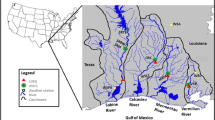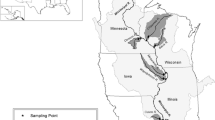Abstract
Freshwater diversions from the lower Mississippi River into the region’s wetlands have been considered an alternative means for reducing nitrogen loading. The Atchafalaya River Swamp, the largest freshwater swamp in North America, carries the entire discharge of the Red River and 30% of the discharge of the Mississippi River, but it is largely unknown how much nitrogen actually can be retained from the overflowing waters of the Mississippi–Atchafalaya River system. Nitrogen discharge from the upper Mississippi River Basin has been implicated as the major cause for the hypoxia in the Northern Gulf of Mexico, which threatens not only the aquatic ecosystem health, but also Louisiana’s fishery industry, among other problems. This study was conducted to determine the change in organic nitrogen mass as water flows through the Atchafalaya River Swamp and into the Gulf of Mexico. By utilizing the river’s long-term discharge and water quality data (1978–2002), monthly and annual organic nitrogen fluxes were quantified, and their relationships with the basin’s hydrologic conditions were investigated. A total Kjeldahl nitrogen (TKN) mass input–output balance between the upstream (Simmesport) and downstream (Morgan City and Wax Lake Outlet) locations was established to examine the organic nitrogen removal potential for this large swamp. The results showed that on average, TKN input into the Atchafalaya was 200 323 tons year−1 and TKN output leaving the basin was 145 917 tons year−1, resulting in a 27% removal rate of organic nitrogen. Monthly TKN input and output in the basin were highest from March to June (input vs. output: 25 000 vs. 18 000 tons month−1) and lowest from August to November (8000 vs. 6000 tons month−1). There was a large variation in both annual and inter-annual organic nitrogen removals. The variability was positively correlated with the amount of inflow water at Simmesport, suggesting that regulating the river’s inflow at the Old River flood control structures may help reduce nitrogen loading of the Mississippi River to the Gulf of Mexico. Furthermore, the in-stream loss of organic nitrogen indicates that previous studies may have overestimated nitrogen discharge from the Mississippi–Atchafalaya River system.
Similar content being viewed by others
References
B. Arheimer H. B. Wittgren (1994) ArticleTitleModelling the effects of wetlands on regional nitrogen transport Ambio 23 378–386
D. F. Boesch (2002) ArticleTitleChallenges and opportunities for science in reducing nutrient over-enrichment of coastal ecosystems Estuaries 25 IssueID4B 886–900
Demas, C. R., S. R. Brazelton & N. J. Powell, 2002. The Atchafalaya Basin – river of trees. U.S. Geological Survey, Fact Sheet FS-021-02
K. J. Devito P. J. Dillon B. D. Lazerte (1989) ArticleTitlePhosphorus and nitrogen retention in 5 precambrian shield wetlands Biogeochemistry 8 IssueID3 185–204 Occurrence Handle10.1007/BF00002888 Occurrence Handle1:CAS:528:DyaK3cXht1Clurk%3D
Donner, S. D., M. T. Coe, J. D. Lenters, T. E. Twine & J. A. Foley, 2002. Modeling the impact of hydrological changes on nitrate transport in the Mississippi River Basin from 1955 to 1994. Global Biogeochemical Cycles 16(3): Art. No. 1043
Donner, S. D., C. J. Kucharik & M. Oppenheimer, 2004. The influence of climate on in-stream removal of nitrogen. Geophysical Research Letters (20): Art. No. L20509
Dunn, D. D., 1996. Trends in nutrient inflows to the Gulf of Mexico from streams draining the conterminous United States, 1972–93. USGS Water-Resources Investigation Report 96-4113
Goolsby, D. A., W. A. Battaglin, G. B. Lawrence, R. S. Artz, B. T. Aulenbach & R. P. Hooper, 1999. Flux and Sources of Nutrients in the Mississippi–Atchafalaya Basin: Topic 3 Report for the Integrated Assessment on Hypoxia in the Gulf of Mexico. Silver Spring (MD): NOAA Coastal Ocean Office. Decision Analysis Series no. 17
D. A. Goolsby W. A. Battaglin B. T. Aulenbach R. P. Hooper (2001) ArticleTitleNitrogen input to the Gulf of Mexico Journal of Environmental Quality 30 329–336 Occurrence Handle1:CAS:528:DC%2BD3MXltVehtrc%3D Occurrence Handle11285892
R. H. Kadlec R. L. Knight (1996) Treatment Wetlands Lewis Publishers New York
D. H. Knight T. J. Fahey S. W. Running (1985) ArticleTitleFactors affecting water and nutrient outflow from lodgepole pine forests in Wyoming Ecological Monographs 55 29–48
Knight, R. L., R. W. Ruble, R. H. Kadlec & S. C. Reed, 1993. Database: North American wetlands for water quality treatment. Phase II report. U.S. EPA
R. L. Knight (1994) ArticleTitleTreatment wetlands database now available Water Environment & Technology 6 IssueID2 31–33
LDEQ, 2000. Louisiana’s Nonpoint Source Management Plan. Volume 6, State of Louisiana Water Quality Management Plan. Baton Rouge, Louisiana
Mitsch, W. J., 1999. Hypoxia solution through wetland restoration in America’s breadbasket. National Wetlands Newsletter 21(6): 9–10, 14
Mitsch, W. J., J. W. Day Jr., J. W. Gilliam, P. M. Groffman, D. L. Hey, G. W. Randall & N. Wang, 1999. Reducing nutrient loads, especially nitrate-nitrogen, to surface water, ground water & the Gulf of Mexico – Identifies and evaluates methods to reduce nutrient loads to surface water, ground water & the Gulf of Mexico. Topic 5 Report for the Integrated Assessment on Hypoxia in the Gulf of Mexico. U.S. Department of Commerce, National Oceanic and Atmospheric Administration (NOAA). Silver Spring, Maryland. NOAA Coastal Ocean Program, Decision Analysis Series No. 19
W. J. Mitsch J. W. Day SuffixJr. J. W. Gilliam P. M. Groffman D. L. Hey G. W. Randall N. M. Wang (2001) ArticleTitleReducing nitrogen loading to the Gulf of Mexico from the Mississippi River Basin: strategies to counter a persistent ecological problem Bioscience 51 IssueID5 373–388
Mitsch, W. J. & J. G. Gosselink, 2000. Wetlands, 3rd edn. John Wiley & Sons
K. E. Murphy B. A. Touchet A. G. White J. J. Daigle H. L. Clark (1977) Soil survey of St. Martin Parish, Louisiana USDA Soil Conservation Service Washington, DC
Nixon, S. W. & V. Lee, 1986. Wetlands and water quality: a regional review of recent research in the United States on the role of freshwater and saltwater wetlands as sources, sinks & transformers of nitrogen, phosphorus & various heavy metals. U.S. Army Eng. Waterways Experiment Station. Technical Report Y-86-2
N. N. Rabalais R. E. Turner D. Justic Q. Dortch W. J. Wiseman SuffixJr. B. K. Sen Gupta (1996) ArticleTitleNutrient changes in the Mississippi River and system responses on the adjacent continental shelf Estuaries 19 386–407 Occurrence Handle1:CAS:528:DyaK28XkvFamsLw%3D
N. N. Rabalais R. E. Turner W. J. Wiseman SuffixJr. Q. Dortch (1998) ArticleTitleConsequences of the 1993 Mississippi River Flood in the Gulf of Mexico Regulated Rivers: Research & Management 14 161–177 Occurrence Handle10.1002/(SICI)1099-1646(199803/04)14:2<161::AID-RRR495>3.0.CO;2-J
N. N. Rabalais R. E. Turner (Eds) (2001) Coastal Hypoxia: Consequences for Living Resources and Ecosystems. Coastal and Estuarine Studies 58 American Geophysical Union Washington, DC
N. N. Rabalais R. E. Turner D. Scavia (2002) ArticleTitleBeyond science into policy: Gulf of Mexico hypoxia and the Mississippi river Bioscience 52 129–142
SAS Institute, 1996. SAS/STAT user’s guide, Version 6.12, 4th ed. SAS Institute Inc., Cary, NC, USA
P. A. Soranno S. L Hubler S. R. Carpenter R. C. Lathrop (1996) ArticleTitlePhosphorus loads to surface waters: a simple model to account for spatial pattern of land use Ecological Applications 6 IssueID3 865–878
Turner, R. E. 1999. Nitrogen losses in water flowing through Louisiana swamps, In Rozas, L. P., J. A. Nyman, C. E. Proffitt, N. N. Rabalais, D. J. Reed & R. E. Turner (eds), Natural System Function and Response to Human Influence. Louisiana Sea Grant College Program, Louisiana Sea Grant Publication, Baton Rouge, Louisiana: 145–154
USDA, 1987. Fram drainage in the United States: History, status & prospects. Economic Res. Serv. Misc Publ. no. 1455. USDA, Washington, DC
F. Leeden Particlevan der F. L. Troise D. K. Dodd (1990) The Water Encyclopedia Lewis Publishers Chelsea, MI
J. T. Watson S. C. Reed R. H. Kadlec R. L. Knight A. E. Whitehouse (1989) Performance expectations and loading rates for constructed wetlands D. A. Hammer (Eds) Constructed Wetlands for Wastewater Treatment Lewis Publishers Chelsea, MI 319–351
Xu, Y. J., 2004. Surface water and sediment inflow and outflow for the Atchafalaya River Basin. In Proc 2004 AWRA Annual Conf., CM ROM, S.J. Nix, ed. Middleburg VA: AWRA
Author information
Authors and Affiliations
Corresponding author
Rights and permissions
About this article
Cite this article
Xu, Y.J. Organic Nitrogen Retention in the Atchafalaya River Swamp. Hydrobiologia 560, 133–143 (2006). https://doi.org/10.1007/s10750-005-1171-8
Received:
Revised:
Accepted:
Issue Date:
DOI: https://doi.org/10.1007/s10750-005-1171-8




